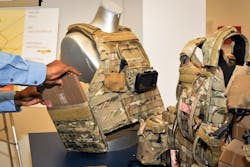Army asks four power electronics companies to develop and build wearable battery for the battlefield
ABERDEEN PROVING GROUND, Md. – U.S. Army power electronics experts are asking four defense contractors to develop a wearable battery to enable infantry warfighters to fight while powering a variety of wearable computers, sensors, and communications devices.
Officials of the Army Contracting Command at Aberdeen Proving Ground, Md., announced that four battery companies will compete for orders potentially worth nearly $1.3 billion over the next nine years to build the Conformal Wearable Battery (CWB).
Companies chosen to develop and build the CWB are:
-- Bren-Tronics Inc. in Commack, N.Y.;
-- Inventus Power LLC in Woodridge, Ill.;
-- Navitas Advanced Solutions Group LLC in Ann Arbor, Mich.; and
-- Ultralife Corp. in Newark, N.Y.
The CWB will be a rechargeable lithium-ion battery that integrates into a soldier’s body armor. The thin, lightweight, and flexible battery will conform to the warfighter's body and be worn in either the side, chest, or back pouches with ballistic protective plates.
Army officials have tested preliminary CWB designs to ensure the battery does not catch fire if hit by enemy bullets or shrapnel.
The CWB is to be a centralized energy source that can power smart phones and computers, the Integrated Visual Augmentation System (IVAS), and the Next Generation Squad Weapon (NGSW), while also providing recharging capability to the batteries in these devices.
The Conformal Wearable Battery will be able to increase infantry mission time without stopping for battery resupply; and eliminate the need to swap-out the batteries in each device.
Related: Army researchers ask Protonex Technology to develop soldier-worn power-management
The idea is for the battery to be virtually invisible and transparent to the soldier. The Army Contracting Command awarded these contracts on behalf of the Power Division of the Army Communications-Electronics Research, Development and Engineering Center’s Command, Power and Integration Directorate at Aberdeen Proving Ground to meet the demands of an increased infantry power burden.
The CWB is to reduce significantly the battery types and quantities the soldier has to carry, and will reduce the carried battery weight attributed to the size, weight, and power (SWaP) necessary to support a mission. The CWB is part of the Tactical Power Generation Program.
The CWB will have a state of charge indicator; generate power continuously for as long as 24 hours; enable infantry operations in remote areas; reduce the need for infantrymen to carry many spare batteries; reduce weight; and increase infantry mobility.
Related: Electrifying advancements
The 150-Watt-hour battery will hold from 10 to 16.8 volts, with nominal voltage of 14. 8 volts; weigh 2.6 pounds; measure 8.7 by 7.66 by 0.7 inches; resist the effects of bullet penetration; and operate in temperatures from -2 to 60 degrees Celsius.
On these contracts Bren-Tronics, Inventus Power, Navitas Advanced Solutions, and Ultralife will compete for each order, and will do the work at sites to be determined with each order, and should be finished by May 2030.
For more information contact the Army Communications-Electronics Command online at https://cecom.army.mil, or the Army Contracting Command at Aberdeen Proving Ground at https://acc.army.mil/contractingcenters/acc-apg/.
About the Author
John Keller
Editor-in-Chief
John Keller is the Editor-in-Chief, Military & Aerospace Electronics Magazine--provides extensive coverage and analysis of enabling electronics and optoelectronic technologies in military, space and commercial aviation applications. John has been a member of the Military & Aerospace Electronics staff since 1989 and chief editor since 1995.
